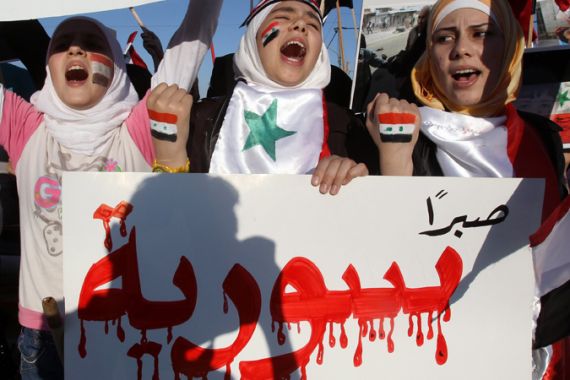‘Scores killed’ in fresh Syria protests
Rights group says at least 63 people killed in crackdown by security forces on anti-government protests on Friday.

Syrian security forces opened fire on some of the largest anti-government protests in the 10-week uprising so far, leaving at least 63 people dead in towns and cities around the country, activists say.
Human rights organisation Sawasiah said 53 demonstrators were killed in the central city of Hama alone on Friday, when security forces dispersed a rally of more than 50,000 people.
The deaths came as president Bashar al-Assad’s forces continued to crack down on protests that seek to end his family’s 40-year rule.
Rami Abdul-Rahman, director of the Syrian Observatory for Human Rights, said the Hama protest was among the largest yet in the uprising that began in mid-March. He said security forces also shot dead one person in the village of Has in the northern province of Idlib.
Historical precedent
Friday’s violence began after Muslim prayers ended, as worshippers left the mosques and marched in cities, towns and villages. Syrian security forces dispersed some, mostly using batons, tear gas and water cannons and fired live ammunition in at least two locations in southern and northeastern towns.
“It is a real massacre. It is terrorism by itself and they want the people to stay silent,” said an activist in Hama. The activist, who like many involved in the protests requested anonymity to avoid reprisals, said hospitals were calling on people to donate blood.
In 1982, al-Assad’s father and predecessor Hafez al-Assad, crushed a Sunni uprising by shelling Hama, killing 10,000 to 25,000 people, according to Amnesty International estimates.
On Friday, a witness in Hama reached, by The Associated Press news agency, described a chaotic scene, with security forces firing tear gas and live ammunition, and snipers shooting from the rooftops as people fled.
“There are many killed and wounded people, the hospital is full,” he said. “I fled the area but I can still hear sporadic gunfire.”
Syria’s state-run TV said three “saboteurs” were killed when police tried to stop them from setting a government building on fire in Hama. The Syrian government blames armed gangs and religious extremists for the violence.
Internet cut
The government also cut internet service across most of the country, a potentially dire blow for a movement that motivates people with graphic YouTube videos of the crackdown and loosely organises protests on Facebook pages.
The internet shutdown, if it continues, could also hamper the movement’s ability to reach the world outside Syria, where the government has severely restricted the media and expelled foreign reporters, making it nearly impossible to independently verify what is happening there.
Syrian troops also pounded the central town of Rastan with artillery and gunfire for a seventh day on Friday, killing at least two people.
The Local Co-ordination Committees, which help organise and document Syria’s protests, said troops also opened fire on residents fleeing the town.
Friday’s protests occurred across the country, from a village in the south to a city in the northeast. Protesters even gathered in several Damascus suburbs, though the capital has not seen the kind of disruption as many other cities.
Rights groups say more than 1,100 people have been killed since the revolt against al-Assad erupted in mid-March.
Remembering fallen children
The opposition had called for nationwide rallies on Friday to commemorate the nearly 30 children killed during the uprising.
In the southern city of Deraa, where the uprising began, scores of people rallied in the city’s old quarter, chanting “No dialogue with the killers of children,” an activist said.
The protesters were referring to a decree by al-Assad to set up a committee tasked with leading a national dialogue.
The call for protests came after a video surfaced earlier this week on YouTube, Facebook and websites featuring Hamza al-Khatib, a 13-year-old boy whose tortured and mutilated body was returned to his family weeks after he went missing during the protests.
The boy has since become a symbol to Syria’s uprising and many people carried his posters during anti-regime rallies this week.